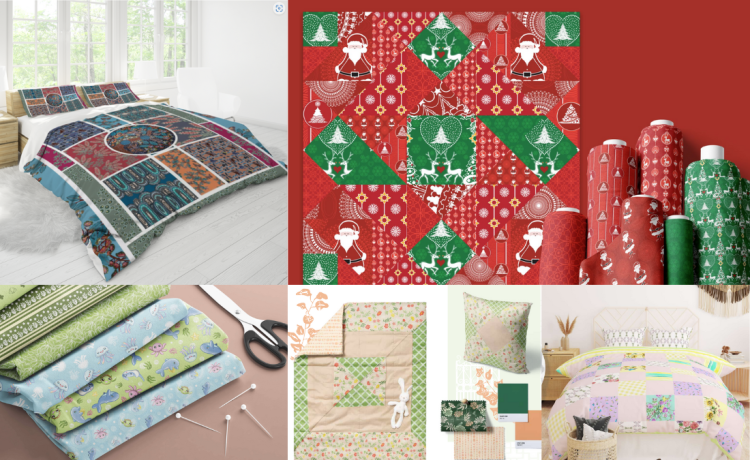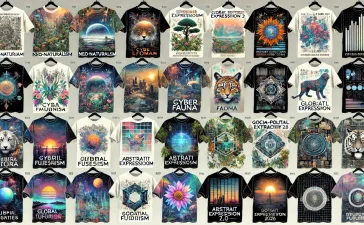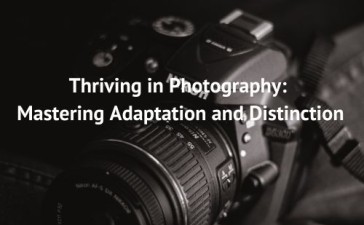As we approach 2025, the quilting fabric industry is poised for exciting changes, driven by evolving consumer preferences, technological advancements, and a growing emphasis on sustainability. This report outlines the key trends and innovations expected to shape the quilting fabric landscape in 2025.
- Sustainable and Eco-Friendly Fabrics
Sustainability will be a primary focus in the quilting industry:
a) Organic Cotton: Increased demand for GOTS-certified organic cotton fabrics.
b) Recycled Fabrics: Quilting materials made from recycled plastics and textiles.
c) Low-Impact Dyes: Fabrics colored using natural or low-environmental-impact dyes.
d) Hemp and Linen Blends: Growing popularity of sustainable plant-based fibers.
Example: Companies like Cloud9 Fabrics are already leading the way with their organic cotton collections.
2. Digital Printing Advancements
Technology will revolutionize fabric design and production:
a) Ultra-High-Resolution Prints: Fabrics with incredibly detailed and lifelike patterns.
b) Customizable Designs: On-demand printing allowing quilters to create unique fabrics.
c) Augmented Reality (AR) Patterns: Fabrics with designs that come to life through AR apps.
d) Digital Colorways: Easy creation of multiple colorways for popular patterns.
Example: Spoonflower’s digital printing service offers a glimpse into the future of customizable quilting fabrics.
3. Smart Textiles for Quilting
Integration of technology into quilting fabrics:
a) Temperature-Regulating Fabrics: Materials that adapt to body heat for all-season quilts.
b) Conductive Threads: Enabling the creation of interactive or illuminated quilt designs.
c) Color-Changing Fabrics: Textiles that alter appearance based on temperature or light.
d) RFID-Embedded Fabrics: For tracking the provenance and care of quilts.
4. Blended Performance Fabrics
Hybrid materials combining natural and synthetic fibers:
a) Cotton-Bamboo Blends: Soft, durable fabrics with natural antibacterial properties.
b) Wool-Synthetic Mixes: Combining warmth of wool with easy-care properties.
c) Silk-Like Polyesters: Luxurious feel with improved durability and washability.
d) Cork-Infused Cottons: Adding texture and water-resistance to quilt designs.
5. Vintage and Retro Revival
A resurgence of classic patterns with a modern twist:
a) Updated 1930s Prints: Fresh colorways for depression-era inspired fabrics.
b) Mid-Century Modern Designs: Bold, geometric patterns from the 1950s and 60s.
c) Digital Reproductions: High-quality digital prints of vintage fabrics.
d) Nostalgic Colorways: Modern fabrics in classic color combinations.
Example: Moda Fabrics often releases collections inspired by vintage designs, which could evolve further by 2025.
6. Global Fusion Aesthetics
Quilting fabrics inspired by diverse cultural traditions:
a) African Wax Print Inspirations: Bold, colorful patterns based on traditional designs.
b) Japanese-Inspired Minimalism: Subtle textures and muted color palettes.
c) Indian Block Print Derivatives: Intricate, hand-carved look achieved through digital means.
d) Scandinavian-Influenced Geometrics: Clean lines and nature-inspired motifs.
7. Texture-Rich Fabrics
Increased focus on tactile experiences in quilting:
a) 3D-Printed Textures: Fabrics with raised patterns for added dimension.
b) Embossed Cottons: Subtle textures added to plain fabrics for visual interest.
c) Mixed-Media Fabrics: Combinations of different fibers for varied textures.
d) Laser-Cut Designs: Intricate cutout patterns integrated into quilting fabrics.
8. Functional Quilting Fabrics
Materials designed for specific uses beyond aesthetics:
a) Antimicrobial Fabrics: For quilts used in healthcare settings or for baby items.
b) UV-Protective Materials: Ideal for outdoor quilts and picnic blankets.
c) Flame-Retardant Fabrics: Meeting safety standards for certain applications.
d) Moisture-Wicking Blends: For quilts used in athletic or outdoor contexts.
10. Sustainable Packaging and Distribution
Eco-friendly approaches to fabric delivery and storage:
a) Plastic-Free Packaging: Fabric wrapped in recyclable or compostable materials.
b) Digital Swatch Books: Reducing paper waste through virtual fabric viewing.
c) Local Micro-Mills: Small-scale, regional fabric production to reduce transportation.
d) Fabric Libraries: Subscription-based access to a wide range of quilting fabrics.
11. Inclusive Design Trends
Fabrics catering to diverse preferences and needs:
a) Gender-Neutral Patterns: Moving away from strictly gendered designs.
b) Cultural Collaboration Collections: Fabrics designed in partnership with indigenous artists.
c) Adaptive Quilting Fabrics: Materials suitable for quilters with different abilities.
d) Size-Inclusive Prints: Scaling patterns to work well for quilts of all sizes.
12. Colorways and Palettes for 2025
Predicted color trends in quilting fabrics:
a) Earth Tones 2.0: Updated, rich versions of natural hues.
b) Nouveau Pastels: Soft colors with added depth and complexity.
c) Vibrant Jewel Tones: Bold, saturated colors for statement pieces.
d) Monochromatic Gradients: Subtle shifts within a single color family.
Example: Pantone’s color forecasts often influence quilting fabric trends. Their website provides regular color trend updates.
13. Interactive and Educational Fabrics
Materials designed to engage and inform:
a) QR Code Prints: Fabrics with embedded codes linking to quilting tutorials or fabric information.
b) Historical Narrative Fabrics: Prints that tell stories or depict historical events.
c) Educational Prints: Fabrics featuring scientific or mathematical concepts.
d) Language Learning Fabrics: Prints incorporating words or phrases in various languages.
Conclusion:
The quilting fabric landscape of 2025 promises to be a vibrant blend of tradition and innovation. As sustainability becomes increasingly crucial, we’ll see a shift towards eco-friendly materials and production methods. Technological advancements will enable unprecedented levels of customization and interactivity in fabric design. The fusion of global aesthetics will create rich, diverse pattern libraries for quilters to explore.
Texture and functionality will play larger roles, with fabrics designed not just for visual appeal but also for specific uses and sensory experiences. The industry will also become more inclusive, offering designs that cater to a wide range of preferences and needs.
These trends highlight the need for continued innovation in fabric production and design. Quilting fabric manufacturers and designers will need to stay agile, adapting to rapidly changing consumer demands and technological capabilities. Collaboration between textile scientists, designers, and quilters will be key to bringing these innovations to market.
For quilters, 2025 will offer an exciting array of new materials and possibilities. From smart fabrics that interact with technology to sustainable options that align with eco-conscious values, the quilting world of 2025 will provide endless opportunities for creativity and expression.
As we move towards this future, it’s important for quilters and fabric enthusiasts to stay informed about emerging trends and technologies. Engaging with online quilting communities, attending fabric and quilt shows, and following industry leaders on social media can help enthusiasts stay ahead of the curve and prepare for the exciting developments coming to the world of quilting fabrics.
Sources for the article:
suggest some reliable sources where you might find supporting information for the trends mentioned in the report:
- Industry publications: Websites like Quilting Daily (quiltingdaily.com) or The Quilting Company (quiltingcompany.com) often feature articles on upcoming trends.
- Fabric manufacturer websites: Companies like Moda Fabrics (modafabrics.com), Robert Kaufman Fabrics (robertkaufman.com), or Riley Blake Designs (rileyblakedesigns.com) frequently showcase new collections and innovations.
- Sustainability-focused textile organizations: The Global Organic Textile Standard (global-standard.org) provides information on organic and sustainable fabric certifications.
- Color trend forecasts: Pantone’s website (pantone.com) offers regular color trend updates that influence fabric design.
- Quilting technology: Websites of companies like Spoonflower (spoonflower.com) showcase advancements in digital fabric printing.
- Quilting trade shows: Websites for events like QuiltCon or the International Quilt Festival often feature information on emerging trends.
To find the most up-to-date and accurate information to support this forecast, I recommend conducting a search using these sources and others related to the quilting and textile industries. This will help ensure you have the latest data and examples to substantiate the trends discussed in the report.
- Find out more
- Launch Pad + Accelerator Expressions of Interest
- Selling and Licensing Your Art & Designs Around the World with ArtSHINE.
- Looking for exciting new Art and Designs to license.
We’re here to help you to take action, just like we’ve helped thousands of other entrepreneurs, business owners, and creative professionals all around the globe.
Now is the time to let your passion SHINE.
Now is the time to Make Tomorrow Today!
To your success, Vinh Van Lam and Stuart Horrex Cofounders ArtSHINE.com





